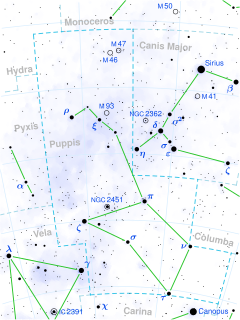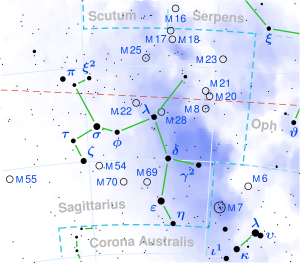
Epsilon Sagittarii, formally named Kaus Australis, is a binary star system in the southern zodiac constellation of Sagittarius. The apparent visual magnitude of +1.85 makes it the brightest object in Sagittarius. Based upon parallax measurements, this star is around 143 light-years from the Sun.

Xi2 Sagittarii, Latinized from ξ2 Sagittarii, is a star in the zodiac constellation of Sagittarius. Data collected during the Hipparcos mission suggests it is an astrometric binary, although nothing is known about the companion. It is visible to the naked eye with a combined apparent visual magnitude of +3.51. Based upon an annual parallax shift of 8.93 mas as seen from Earth, this system is located around 370 light years from the Sun.

Xi1 Sagittarii (ξ1 Sagittarii) is a solitary, blue-white hued star in the zodiac constellation of Sagittarius. It is visible to the naked eye with an apparent visual magnitude of +5.06. Based upon a small annual parallax shift of 1.58 mas as seen from Earth, this system is located roughly 2,100 light years from the Sun.

Beta² Sagittarii is a star in the zodiac constellation of Sagittarius. It is visible to the naked eye, having an apparent visual magnitude of +4.29. Based upon an annual parallax shift of 24.31 mas as seen from Earth, it is located 134 light-years from the Sun.

X Sagittarii is a variable star and candidate binary star system in the southern constellation of Sagittarius, near the western constellation boundary with Ophiuchus. It has a yellow-white hue and is visible to the naked eye with an apparent visual magnitude that fluctuates around 4.54. The star is located at a distance of approximately 950 light years from the Sun based on parallax, and is drifting closer with a radial velocity of −10 km/s. The star has an absolute magnitude of around −2.85.

Chi1 Sagittarii (χ1 Sagittarii) is a binary star system in the zodiac constellation of Sagittarius. The pair have a combined apparent visual magnitude of +5.03, which is bright enough to be seen with the naked eye. Based upon an annual parallax shift of 12.95 mas as seen from Earth, it is located around 252 light years from the Sun. It is advancing through space in the general direction of the Earth with a radial velocity of −43.4 km/s.

Chi3 Sagittarii (χ3 Sagittarii) is a solitary, orange-hued star in the zodiac constellation of Sagittarius. It is faintly visible to the naked eye with an apparent visual magnitude of +5.45. Based upon an annual parallax shift of 6.53 mas as seen from Earth, it is located roughly 500 light years from the Sun. It is receding from the Earth with a radial velocity of 39.6 km/s.
12 Canis Majoris is a variable star located 750 light years away from the Sun in the southern constellation of Canis Major. It has the variable star designation HK Canis Majoris; 12 Canis Majoris is the Flamsteed designation. This body is just barely visible to the naked eye as a dim, blue-white hued star with a baseline apparent visual magnitude of +6.07. It is moving away from the Earth with a heliocentric radial velocity of +16 km/s. This is the brightest star in the vicinity of the open cluster NGC 2287, although it is probably not a member based on its proper motion.

HD 93250 is a highly luminous hot blue binary star in the Carina Nebula in the constellation Carina.

HD 74180 is a binary star in the constellation Vela. It is approximately 3,200 light years from Earth. The primary component is a yellow-white F-type supergiant with a mean apparent magnitude of +3.81, with a 10th magnitude companion 37.5 arcseconds distant.
V1401 Aquilae is a single, semi-regular pulsating star in the equatorial constellation of Aquila. It has the designation HD 190390 from the Henry Draper Catalogue, and was formerly designated 64 Sagittarii. The evolutionary status of the star is unclear, and it has been classified as a post-AGB object, a UU Herculis variable, or belonging to the W Virginis variable subclass of the type II Cepheids. It is dimly visible to the naked eye with an apparent visual magnitude that fluctuates around 6.38. Based on parallax measurements, it is located at a distance of approximately 2,380 light years. It lies 21.5° from the galactic plane.
V4381 Sagittarii is a variable star in the constellation Sagittarius. A white supergiant of spectral type A2/A3Iab, it is an Alpha Cygni variable that varies between apparent photographic magnitudes 6.57 and 6.62. Its visual apparent magnitude is about 6.54.

HD 165516 is a blue supergiant star in the constellation Sagittarius. It is part of the Sagittarius OB1 association and appears against a rich Milky Way starfield near the Triffid Nebula and Lagoon Nebula.

9 Sagittarii is a massive binary star in the constellation Sagittarius. It has an apparent magnitude of 5.97.

V518 Carinae is a naked-eye variable star in the constellation Carina. It is a member of the bright open cluster IC 2602 near the Carina Nebula.

HD 93194 is a star in the constellation Carina. Its apparent magnitude is 4.79. Its parent cluster is IC 2602.

HD 93607 is a star in the constellation Carina. Its apparent magnitude is 4.87. Its parent cluster is IC 2602.

χ Puppis, Latinised as Chi Puppis, is a single star in the southern constellation of Puppis. It has a white hue and is faintly visible to the eye at night with an apparent visual magnitude of 4.79. The star is located at a distance of approximately 1,800 light years from the Sun based on parallax, and is drifting further away with a radial velocity of +30 km/s. O. J. Eggen listed this star as a member of the Hyades Stream based on its space motion.

52 Sagittarii is a binary star system in the southern constellation of Sagittarius. It has the Bayer designation h2 Sagittarii, while 52 Sagittarii is the Flamsteed designation. This system is visible to the naked eye as a faint, blue-white hued point of light with an apparent visual magnitude of 4.59. It is located approximately 190 light years away based on parallax, but is drifting closer with a radial velocity of −19 km/s.
π2 Gruis, Latinised as Pi2 Gruis, is a binary star system in the southern constellation of Grus. It is faintly visible to the naked eye as a yellow-white hued star with an apparent visual magnitude of 5.622. Based upon an annual parallax shift of 25.1 mas as seen from the Earth, the system is located 130 light years from the Sun.







